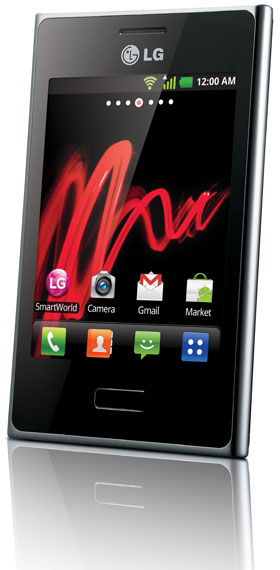 It’s all too easy to get wrapped up in the latest top-end devices with their multiple cores and mega-megapixel cameras. For the bulk of consumers, budget smartphones are a far more exciting prospect. Korean electronics company LG’s Optimus L3 is just such a device, offering great functionality at a low price.
It’s all too easy to get wrapped up in the latest top-end devices with their multiple cores and mega-megapixel cameras. For the bulk of consumers, budget smartphones are a far more exciting prospect. Korean electronics company LG’s Optimus L3 is just such a device, offering great functionality at a low price.
The L3 is small, lightweight and devoid of any frills. Its exterior offers a volume rocker on the left-hand side, a 3,5mm audio jack and power/lock button on its top edge, and a micro USB port on its bottom.
Like the bulk of touch-screen devices, the L3 has a single button beneath its 3,2-inch capacitive display that returns users to the home screens.
The display is small and offers a resolution of only 240×320 pixels and a dismal pixel density of 125ppi. But then you can’t exactly expect an Apple Retina-type display R1 499, which is what the LG phone will set you back.
Though the screen isn’t great looking, it’s sufficiently responsive, typing is easy enough — though haptic feedback for key-press reassurance would’ve been welcome — and as the L3 runs Android 2.3 (Gingerbread), software functionality is excellent.
LG overlays its own LG Optimus user interface. Before you groan about yet another Android skin, this one is a fairly light addition to the basic Android operating system and includes a smattering of useful additions like the connectivity shortcut toggles at the top of the pull-down notification area.
The home pages scroll left and right, but thanks to the user interface interference from LG, the applications menu scrolls up and down making it difficult to see exactly how many applications are installed or where exactly in the list you are at any given time.
Like most of its Android-based brethren, the L3 supports microSD cards up to 32GB and, considering its price, the fact that there’s 1GB of flash memory to start with is pretty impressive. The processor is also surprisingly capable, despite being a diminutive 800MHz — moving between menus and apps is surprisingly lag-free.
The processor also makes Web-browsing a speedy affair but the screen resolution means it’s not particularly well suited to reading anything beyond an e-mail or two or looking up a short snippet of information. Still, for those without any other way to browse, it’ll provide a surprisingly fluid experience.
Even the camera on the L3 is tolerable: it’s only three megapixels, without any sort of flash and shoots video at VGA (640×480 resolution), but it’s functional enough. Those looking for a high-quality mobile phone camera doubtless know that entry-level phones aren’t the place to find such things.
The L3 supports all of the expected audio and video formats, includes an accelerometer and GPS, offers a stereo FM radio and connects to Wi-Fi. It also acts as a Wi-Fi hotspot and even works as a DLNA media-streaming device.
Really the only thing that lets the L3 down is its dreadful screen. Otherwise, it’s a pretty decent compact smartphone. The shoddy screen is explained by the price, and it’s arguably one of the last obstacles manufacturers face in the battle to produce high-quality cheap smartphones.
Smartphone prices are reaching price points previously reserved for the top end of the feature-phone market and, with the price of data falling steadily, this means more people with Internet access in their pockets. This can only do good things for emerging markets.
The L3 is an excellent example of how far phone manufacturing has come. It’s not the best handset in the market by a long stretch, but then it’s not pretending to be. It is, however, one of the better budget handsets out there for those that still want most of the functionality pricier devices offer. It’s cheap, but it’s still smart. — (c) 2012 NewsCentral Media




